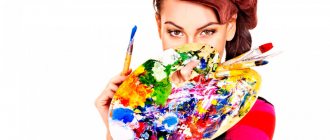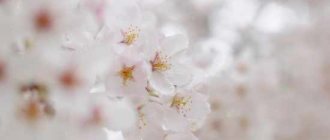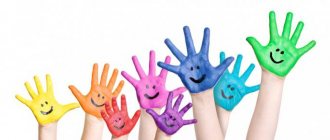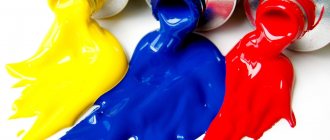What colors can you use to determine a person's character?
Representatives of public professions - people who speak in front of the public (actors, TV presenters, journalists, musicians, and others) often use the services of professional stylists who help them choose the right wardrobe that matches the situation and the person’s general image, taking into account all sorts of factors. Stylists select the right color of things. Due to the specifics of their work, representatives of public professions appear in public more often than others, in front of spectators or on television screens. If mistakes are made in choosing a color scheme, this will become an object of discussion for the viewer, and ultimately may cost such people their reputation and job.
From a psychological point of view, color in clothing, as well as in areas of activity (marketing, design, advertising, business) can become the object of consideration, identifying some patterns and general observations. First of all, we are talking about the fact that the main color that prevails when choosing things can give some information about a person’s personality. This article contains some of these conclusions, based on research by psychologists and the work of clothing designers. Below is a description of the most popular colors.
Color symbols
All national color symbols have a broad general meaning, which was used by philosophers, theologians, scientists and artists. Systems of color symbolism have similar characteristics that divide them into several groups.
Natural color symbols
The first group has the most common and most ancient color symbols. Due to associativity with nature.
- White color - Light, Silver
- Blue color - Sky, Air
- Black color - Darkness, Earth
- Red color - Fire, Blood
- Yellow color - Sun, Gold
- Green color – Nature, Plants
Characteristic color symbols
Second group . Color symbols have a vague resemblance to the characteristic features of an object or concept and in a specific situation acquire cognitive meaning. As a color metaphor, they acquire an expressive meaning in painting, color photography and in the art of various decorations:
- White color - Luminosity, Spirituality, Purity, Innocence, Clarity
- Black color - Absorption, Materiality, Lightlessness, Heaviness
- Yellow color - Radiance, Lightness, Dynamism; Closeness, Joy
- Blue color - Heavenly, Depth, Infinity, Coldness, Impassivity
- Red color - Activity, Violence, Excitement, Passion
- Green color - Calm, Safety, Static, Beneficial
Conventional color symbols
The third group is the most diverse and most conventional symbols, the color of which has no resemblance to the designated object or concept. They make up the code color symbols of the abstract designation:
- Yellow color - Buddhism, Wealth, Envy, Jealousy
- Blue color - Religiosity, Wisdom
- Red color - Democracy, Evil, Tsar, Bon religion, Tuesday
- Green color - Islam, Mediocrity, Moon, Resolution, Angel
Colors and cardinal directions
In China, there is a system of correspondences that combines colors and cardinal directions:
- East - Green color
- South - Red color
- West - White color
- North - Black color
- Center - Yellow
Color is very important in Chinese symbolism, acting as an indicator of social status.
Color symbols of estates (castes)
In India, all four main castes (varnas) had their own color symbols, which had an ethical interpretation:
- Brahmins (priests) - White color (goodness)
- Kshatriyas (military nobility) – Red color (passion)
- Vaishyas (community people) - Yellow color (a mixture of the first two qualities)
- Shudras (servants) - Black color (darkness)
Ascetic beggars, as a sign of renunciation of human society, voluntarily took on yellow-orange attire, which was usually worn by convicted criminals going to the place of execution.
The main flows of each color in a brief description
- White color is a connection with your higher self, with God.
- Yellow color is the energy of information that longs to become your wisdom, your experience.
- Blue color is male Divine energy with a plus sign.
- Blue color is the energy of understood information, acquired wisdom, Knowledge that has become Yours, the energy of Faith.
- Purple color is the energy of compassion, forgiveness, healing.
- Red color is aggression - hence the uncertainty, the desire to be the very first and the best, the inability to be one, because - look from the beginning and so on in a circle. Like a woman in red: “I want to be with you - get away from me, you vile man!”
- Orange color - strength, power, huge potential of mental and physical energy.
- Brown color - decay, decomposition, heavy information that a person could not “digest”; a problem, a complex, remained. Only yellow and red can turn into brown.
- Black color is emotions, it is birth, it is feelings in their initial stage, it is seeds, it is sensuality.
- Green color is our protection, harmonization, health, self-confidence.
- Gray color - restriction, discipline, seriousness, the need to maintain secrecy, isolation.
- Silver color - activity, energy, creativity.
- Golden color - pomp or altruism (depending on the spiritual level of a person).
Black is the color of mourning
In psychology there is such a branch as color therapy. Some of the industry's observations apply to clothing selection. In Slavic culture, black is considered to be the color of sadness and mourning, while in China, on the contrary, black symbolizes childhood and personifies joy and carefreeness.
Along with white - black when choosing clothes - classic, neutral. This means that in black clothes you will not look ridiculous or out of place.
Psychologists believe that black is a sign of confident, trustworthy people. As already mentioned, in Slavic culture black is the color of sadness and mourning, so if you are not going to a funeral ceremony, it is worth diversifying the monotonous black color scheme with bright accessories.
Black - sophistication, officialdom, luxury and sorrow
Meanings. Black symbolizes classics and, despite its connection to death and everything mysterious, if used correctly, it can make your brand the most recognizable. In branding, black is associated with exclusivity and luxury.
Helpful advice. Black goes well with gold and white. Texture plays an important role: depending on whether it is matte or glossy, the message of the design idea may change.
Symbols of the Design Film Festival
Thanks to the combination of different textures and black and white colors, the logo design turned out to be classic, but at the same time incredibly sophisticated and extravagant.
Brown clothes are the choice of successful people
Brown is simply perfect for putting people at ease. It evokes associations with coziness and comfort, which means a person who uses this color in his wardrobe appears as reliable and respectable. Therefore, for business negotiations and important business meetings, brown clothes and shoes will be an excellent choice.
If you need to improve your first impression of yourself, for example, during a job interview, wearing brown clothes is a must. Business people, representatives of the trade and financial spheres quite often use this little trick from the field of psychology. It doesn't even have to be an item of clothing. A brown scarf, gloves or briefcase will also do an excellent job of winning over a person on a subconscious level, and he may not even know why this is happening.
Coloristics
Coloristics is the science of color.
After studying it, you will understand why we see this or that color, what emotions it evokes. Color can stimulate action, cause anxiety, or, conversely, calm. With the help of color, we can emphasize important information, or, conversely, make unimportant information less noticeable. Color has a strong influence on people's emotions. Therefore, when choosing a particular color, it is necessary to take into account the peculiarities of the psychology of its perception. Each person can react to certain colors in their own way, but there are also general emotional responses that must be taken into account when designing websites, outdoor advertising, interiors, etc.
In addition to choosing a color, it is also necessary to take into account the problems of combining certain colors. Color combinations can be either complementary or contrasting. By choosing the right color combination, you can set a person up for relaxation, or vice versa, intensify his attention.
Blue is the color of wisdom
Blue color is also very popular among business people. Many official enterprises specify the presence of blue wardrobe elements in their dress code. In many cultures, blue is considered a symbol of wisdom and peace.
In many ways, blue is similar to black, but when darker shades are used, it is perceived almost as neutral. However, it is considered more open, and to other people, a person whose wardrobe contains blue tones seems more ready for contact and constructive communication. Blue color helps overcome excitement and anxiety. Just like brown, it is quite capable of fulfilling the function of gaining additional trust among people around.
Tint, tone, and shade
These terms are often misused, but they describe a fairly simple concept in color. The main thing to remember is how different the color is from its initial hue. When white is added to a color, this lighter variety of color is called a “tint.” When a color is made darker by adding black, the resulting color is called a “shade.” If you add gray, each gradation gives you a different tone.
Shades (add white to pure color).
Shadows (add black to pure color).
Tonalities (add gray to pure color).
Green is the color of heaven
This is precisely the opinion held by representatives of Islamic culture. Psychologists largely agree with this, saying that green and its shades are one of the most pleasant to perceive. In Slavic culture, there is a logical connection between green and plants and their not yet ripe fruits.
When translated into psychology, green symbolizes youth, adolescence and some immaturity. This trend is also observed in the choice of colors used in the wardrobe. Green color is often used by representatives of the younger generation. This is especially true for slightly lighter shades of green such as light green and light green. But this trend is not some kind of absolute rule, which means green, due to its aesthetic appeal, can be used by any people.
Green - naturalness, vitality, prestige and wealth
Meaning. The color green gives rise to two completely unrelated associative series at once: on the one hand, it is naturalness and environmental friendliness, on the other, money and wealth. Green is the color of foliage and nature, but at the same time it is the color of American currency, which is symbolized throughout the world with wealth and luxury.
Helpful advice. Light green shades are synonymous with freshness, vitality and renewal; The deep dark green palette represents prestige, wealth and abundance.
Symbolism of the Kokoro & Moi festival
The Kokoro & Moi food festival has chosen green as a symbol of fresh and organic food.
Business cards of the organizers of the Filmfaktisk film festival
The dark green (earthy, pine) shade in the festival logo is a symbol of prestige and depth.
Purple is the color of the elite
With the modern level of technology development in the chemical industry, it has become possible to obtain an artificial dye of any desired shade. But in ancient times, dyes were extracted only from natural materials. In the natural environment, purple is not a very common color. So it turned out that things made of purple fabric were incredibly expensive, and automatically became a luxury item. And only the richest and most successful people, for example, members of royal families, could afford such luxury. A lot of time has passed, but the meaning of purple in clothing has not changed; it still continues to evoke associations with luxury, grandeur and wealth.
Purple - royalty, majesty, spirituality and mystery
Meaning. The purple palette evokes rather neutral emotions. Deep shades create an atmosphere of mystery and grandeur, while lilac, lavender or amethyst look feminine and sentimental.
Helpful advice. Research shows that purple is most suitable for female audiences. For well-known brands, the use of this color is rather an exception.
Tidepool business cards
For medical software company Tidepool, using dark purple is a way to stand out from the crowd of competitors and emphasize its status.
Business card of Bella Casa design agency
The purple color in the Bella Casa logo symbolizes the French charm and chic of Victorian interiors. An excellent choice for a design company.
Red is the choice of the brave and decisive
In terms of perception, red is opposed to green. For the human eye, red is, to a greater extent, an aggressive and defiant color. In Slavic culture, some rejection of this color is due to the fact that red is the color of blood, which means danger and aggression. Therefore, the choice of clothing using red should be approached with caution.
It is unlikely that choosing clothes that include red elements for everyday wear will be the right choice. It is advisable to use aggressive colors such as red that attract too much attention, in combination with other colors, such as black. Also, the right decision would be to use red not in clothes, but in accessories designed to complement the main image. For women, this could be a small red clutch bag.
Coloristics
Characteristics of flowers. Tones. Psychological impact of color. Magic of color.
Color is the property of light to cause a certain visual sensation in accordance with the spectral composition of the reflected or emitted radiation. Light of different wavelengths excites different color sensations; Radiations from 380 to 470 nm are violet and blue, from 470 to 500 nm - blue-green, from 500 to 560 nm - green, from 560 to 590 nm - yellow-orange, from 590 to 760 nm - red. However, the color of complex radiation is not uniquely determined by its spectral composition.
- Hue
(color) - the name of the color (red, blue,...). - Intensity
is the level of color concentration (the predominance of one or another tone). - Depth
is the degree of brightness or mutedness of the tonality of a color. - Lightness
- the degree of whiteness (% presence of white and light gray tones in the color). - Saturation
- % presence of dark gray and black tones. - Brightness
is a characteristic of luminous bodies, equal to the ratio of the intensity of light in any direction to the area of projection of the luminous surface onto a plane perpendicular to this direction. - Contrast
is the ratio of the difference in brightness between the object and the background to their sum.
Color is a qualitative characteristic of electromagnetic radiation in the optical range, determined on the basis of the emerging physiological visual sensation of color. Color depends primarily on the spectrum. The sensation of color occurs in the sensitive cells of the retina of a person or other animal - cones. There are three types of cones - “red”, “green” and “blue”, respectively, each color sensation is represented as the sum of the sensations of these three colors.
Color affects a person’s physiological processes and his psychological state. Knowing the characteristics of each color, you can form a certain image, evoke certain emotions and associations.
Red color (compensating green) is the most active. This is a rich, heavy, hot, bright color. It symbolizes passionate love, power, fire, war. Light shades of red are stimulating, dark shades give solidity. Red color corresponds to the planet Mars.
For the Chinese, red is a symbol of good luck, happiness, nobility, and for the Indians it represents life and action.
Stimulates, supplies very strong, but quite rough energy. Promotes activity, confidence, friendliness. In large quantities it can provoke rage and anger.
Physiology: stimulates the nervous system, releases adrenaline, improves blood circulation, increases the number of red cells in the blood, increases sexuality and sexual desire. Psychology: gives a sense of security, confidence in the future, helps to cope with troubles easier. Forms a leader.
Orange color (compensating for blue, cyan) is low-saturated, warm, light, sexy. It has a stimulating effect. Orange color stimulates the emotional sphere, creates a feeling of well-being and fun. It symbolizes pleasure, celebration, nobility. Orange color corresponds to Mercury.
Releases emotions, raises self-esteem, teaches forgiveness. An excellent antidepressant, promotes a good mood. Pastel shades (apricot, peach) restore nervous energy.
Physiology: located between the red and yellow colors of the spectrum, therefore it has the properties of these two colors. Gives energy like red and promotes thought process like yellow. Psychology: clears unpleasant feelings, helps to accept negative events in life (for example, a breakup or the loss of a loved one), helps to forgive another person, let go of an insoluble situation. If you are at a dead end and afraid of changes that will open up new horizons in life, turn to the color orange.
Yellow color (compensating purple) is warm, light, bright, flowing, joyful. It evokes pleasant sensations and symbolizes movement, joy and fun. Yellow color promotes the activation of mental activity. Yellow—remains in memory for a long time. But in combination with other colors it can evoke opposite emotions. For example, greenish-yellow and gray-yellow shades personify envy, falsehood and have a repulsive effect. Yellow color corresponds to the Sun.
In Brazil, this color is a symbol of despair, and in combination with purple it is a symbol of illness; among Syrian Muslims it is a symbol of death. In China, on the contrary, yellow is very popular as it is a symbol of empire and splendor. For Russian people, yellow is a sign of separation and betrayal.
A joyful, stimulating color. It is associated with intelligence and expressiveness. It increases concentration, organizes, improves memory, and promotes fair and quick decision making. Yellow helps you accept new ideas and other people's points of view. This is the color of optimism.
Physiology: treats the digestive system well and ensures its functioning. Mainly affects the flow of bile, which plays a role in the absorption and digestion of fats. Improves memory. Psychology: sets feelings in motion, frees from negativity, which undermines self-confidence. Makes it easier to accept new ideas and accept different points of view. It promotes better self-organization and concentration of thought. For children: increases cognitive interest. Can be used for children's rooms, but in limited quantities, otherwise children will not be able to sleep peacefully.
Green color (compensating for red) is rich, calm, fresh, gentle, calming, lively. It has a calming effect. It symbolizes peace, tranquility, love, salvation. Green color corresponds to the planet Venus. Green is a popular color in Mexico, Australia, Ireland and Egypt. In China, green symbolizes luxurious life and youth; in India - peace and hope.
Life, growth, harmony. It unites us with nature and helps us be closer to each other.
Physiology: helps with negative conditions: imbalance, anger, rudeness, stiffness in emotions and feelings. Psychology: when you lack green, you are deprived of harmony. Not recommended if you need to make quick decisions, as green is relaxing.
Blue color (compensating orange) is slightly saturated, light, airy, cool, calm, slightly passive. It symbolizes purity, intelligence, constancy and tenderness. If there is too much blue, it can cause laziness and apathy.
For the Chinese, blue is one of the mourning colors; in India - a symbol of truthfulness; in Brazil it is a symbol of sadness.
Blue is considered the color of creativity and is recommended for classrooms or offices. The turquoise hue promotes communication.
Physiology: helps with insomnia, helps you fall asleep, as it has a relaxing effect. Has an astringent and anti-inflammatory effect. Psychology: helps with negative mental states: shyness, fear of speaking, bad relationships. With the help of blue, you can detach yourself from the outside world and, left alone with your thoughts, contemplate and reflect calmly. When engaging in meditative practices, it is useful to light a blue candle or a blue lamp. Promotes creativity.
The blue color (compensating for the orange) is very rich and very cool. It is heavy, strict, mysterious, pure. The first feeling it evokes is a feeling of wariness. The blue color symbolizes the universe, space and corresponds to the planet Jupiter.
Calming color. It promotes physical and mental relaxation, creates an atmosphere of security and trust.
Physiology: treats deafness, cataracts, bleeding, insomnia. Is an anesthetic. Helps with sore throats and rheumatism. Affects the endocrine system. Psychology: develops mental abilities. Clears thinking, frees you from worries and fears, allows you to hear your inner voice and make the right decision (intuition). With indigo it is easier to move to more subtle levels of consciousness. Not recommended for people prone to seasonal depression.
Violet color (compensating yellow) is rich, cold, heavy, calm, mysterious. It symbolizes wisdom, maturity, higher intelligence. Violet color is easily suppressed by other colors, but violet color itself is deep and expressive. It gives clothes a solemn and luxurious look. In large quantities, the color purple causes melancholy. Corresponds to the planet Uranus.
Associated with artistry, great ideas, intuition and mysticism. It promotes inspiration, compassion, sensitivity.
A majestic color that has always been present in the clothing of kings and clergy. This is the color of inspiration, which is characteristic of healers and creative individuals. It will help you learn to accept everything that happens to you with a calm heart, calm your soul and nourish it with the energy of inspiration. Purple unites the body and mind, material needs with the needs of the soul. People with a predominance of violet color in their aura make skilled healers, and if they are engaged in creativity, then their works are distinguished by their naturalness and language that is understandable to everyone. Violet balances the two ends of the spectrum, and also balances the masculine and feminine energies in the human body.
Physiology: treats physiological diseases: concussion, epilepsy, neuralgia, multiple sclerosis. Not recommended for people with severe mental illness and alcoholism. Psychology: helps with negative mental states: neurosis, loss of faith, despair, loss of self-esteem.
Black
-: motivated use of force, creation, learning, ability to foresight, meaningfulness, hidden treasures, destructiveness, use of force as a manifestation of weakness and selfishness, suppression, depression, emptiness, abstinence, restrictions. Black hides what he has. A person who prefers it seeks to hide his inner world from others. Black symbolizes the end. Every evening we are happy to return to the night to recuperate. But it is he who gives rise to everything new. Life begins with the unknown. Black is able to control the situation thanks to secret knowledge. Black seeks to maintain his power by any means necessary. On the other hand, this person feels the need for external control. Power, sexuality, complexity, formality, elegance, richness, mystery, fear, evil, anonymity, discontent, depth, style, sadness, remorse, anger, underground, good techno color, mourning, death (Western cultures).
White
- intactness, completeness, dedication, unity, lightness, revealing the hidden and false, isolation, sterility, numbness, disappointment, stiffness, boredom. The main quality of white is equality. White color seeks justice. He is impartial. White color symbolizes innocence. This is the color of a real bride, a girl who has not yet known passion. White is characterized by a certain density. Holding a transparent crystal in your hands, you see the Radiance in front of you. When you pick up a white cotton sheet, you can't see anything through it. White is one step below the impeccable purity of Radiance. White contains all the colors of the spectrum equally, being the result of their mixing. Therefore, white can be used to create certain combinations. All colors in white are equal. In mythology, white serves as a symbol of unity. White seeks justice. The white wig on the judge's head indicates his impartiality. White is a spiritual guardian. If white is present, then everything will be fine. A doctor in a white coat snatches a man from the jaws of death. Reverence, purity, simplicity, peace, humility, precision, innocence, youth, birth, winter, snow, good, sterility, marriage (Western cultures), death (Eastern cultures), cold, clinical, sterile.
Grey
- safety, reliability, intelligence, sedate, modesty, dignity, completeness, firm, conservative, practical, old age, sadness.
Grey, black and white
(tones) - are the connecting link for colors. They have no effect. They are a background for flowers and increase the intensity of the color nearby, and when added, they increase the lightness (light gray, white) or saturation (dark gray, black) of the color.
When talking about the psychological impact of color, it is important to take into account the fact that different societies have different points of view. Even independent research results on the effects of color sometimes bear the imprint of belonging to a particular cultural group of people whose opinions have been formed over the centuries.
The symbolic meaning of flowers has developed among certain peoples over the centuries. Take, for example, black and white colors. In the West, black is perceived as a serious, dramatic, and sometimes sad color. When using black color in decoration, warnings are often heard about its depressing effect. Traditionally, black is the color of mourning. White color, on the contrary, is associated with purity, peacefulness, and optimism. Therefore, wedding dresses in Western countries are traditionally white. It would never occur to anyone to wear white clothes to a funeral ceremony, or for a bride to attend a wedding in a black dress. However, in some Eastern countries, white, and not black, is the color of mourning.
Each color has its own magical power. It’s not just that a wedding dress should be white, because it is a symbol of purity. The roses we give to our loved ones should be red. Each color has its own magical symbol. We encourage you to read about primary colors and what they mean.
Divine color. Symbol of light, purity and truth. In most countries (European countries, China, Egypt, etc.) white is the color of mourning clothes. White robes were used to initiate the deceased into a new life. This is the color of joy and celebration. Controversial symbol. Combining light and life on the one hand, and old age, blindness and death on the other. In China, white was associated with both treachery and purity. The Scandinavian goddess of death Hel, who lives in the icy (white) world of death Hel, has a deathly white face. Everyone knows the expression “white crow,” but what is a “white elephant”? This expression came to us from ancient Siam. To get rid of an unwanted courtier, the King of Siam gave him a large white elephant. The cost of feeding the animal quickly ruined the courtier, and it was impossible to get rid of the royal gift. Since then, a large, impressive, but useless acquisition has been called a “white elephant.” “Lily-colored liver” (“white liver”) - the expression comes from the belief that the liver of cowards has no blood. “Show a white feather” - show cowardice. The expression comes from cockfighting. Red and black roosters have been observed to rip feathers from the tails of the more cowardly white roosters. Interestingly, the word “candidate” comes from the Latin “candidus” (“dazzling white”). White dove - symbolizes peace, the Holy Spirit. White eggs - creation. White flag - voluntary surrender, truce. White is the color of cleansing from sins, baptism and communion, the holidays of Christmas, Easter and Ascension. In alchemy, white is associated with mercury.
Blue, like white, is a divine color. Blue is associated with Jupiter, Juno, Amon-Ra, Vishnu and other gods. In China, blue is a symbol of Tao. The Sacred Path, the principle of existence. Like white, blue is the color of truth, fidelity, chastity and justice in the Christian tradition. Light blue color is a symbol of the incomprehensible and wonderful.
The symbolism of yellow largely depends on its tone. Warm yellow tones are a symbol of an unbreakable marriage, while cold yellow tones are a symbol of adultery (the color of cuckolds in France). Yellow is the color of gold, a symbol of the sun and divine power. In Greek mythology, yellow is the color of Apollo. In China, yellow is the color of the emperor. During the Qing Dynasty, only the emperor had the right to wear yellow clothes. In addition, yellow is the color of betrayal, jealousy, cowardice, and lies. In some European countries, the doors of the houses of criminals and traitors were smeared with yellow. Judas and Cain are usually depicted with yellow beards. During World War II, in Nazi-occupied countries, Jews were required to wear yellow “bands of shame.” Yellow color was chosen by Gautama Buddha as a symbol of humility. Yellow is the color of illness. A yellow cross was placed on plague houses. A yellow flag on board the ship indicated that there were infectious patients on board. Now the yellow flag is raised when they want to say that there are no sick people on the ship (when entering a foreign port). In football and in traffic laws, yellow is a warning.
Color and all its shades (the color of earth) are preferred by those who have firmly and confidently stood on their feet. People who have a soft spot for him value traditions and family. When he is unpleasant, it speaks of pride and selfishness, that this person is secretive and has difficulty being frank.
The color red symbolizes blood, fire, anger, war, revolution, strength and courage. In addition, red is the color of life. Prehistoric man sprinkled blood on the object he wanted to revive. In ancient Rome, the color red symbolized divinity. It is the color of the nobility, patricians and emperors of Rome. A symbol of supreme power, which later passed to the cardinals. After victory, Roman generals painted their faces (in honor of Mars) red. The Red Ensign has been in use in the British Navy since the 17th century and symbolizes a "challenge to battle". The red flag was used during the Paris Commune of 1817, in our country during the uprising of 1905, the revolution of 1917 and the next few decades. The term "Reds" is often used to refer to communists. Red is the color of anarchy. Supporters of the Italian national leader Giuseppe Garibaldi (1807-1882) were called “red shirts” because they wore red shirts as a sign of disobedience to the authorities. The red rose is a symbol of love and beauty. The expression “red calendar day” comes from the custom of marking saints’ days and other church dates with red ink. This color is used to warn of danger (for example, road signs). The area where the brothels are located is called the “red light” area, since these are the lights that used to hang in front of such establishments.
The favorite color of people with intuition and passionate dreamers. According to heraldry, this color also means hypocrisy and pretense. In heraldry - the color of meanness and betrayal.
The favorite color of sensible and distrustful people who think for a long time before making any decision. It is also a neutral color favored by those who are afraid to make a statement too loudly. If you don’t like this color, then this is an indicator of an impulsive, frivolous character.
The color of the sky and sea, a symbol of height and depth. Constancy, loyalty, justice, perfection and peace. In ancient Egypt, blue was used to represent truth. Blue is the color of Zeus (Jupiter) and Hera (Juno). The Order of the Garter, the highest order of chivalry of the British Crown, wears a wide blue ribbon. The order was founded in 1348 by Edward III. Blue is the color of royalty and noble birth. The expression "blue blood" for people of high birth originated from the belief that the veins of Spanish aristocrats were "bler" than those of common people. The expression “bluestocking” in relation to a learned lady dates back to the 15th century, when a society of men and women engaged in the study of science gathered in Venice, blue stockings being their distinctive attribute of clothing. This custom was adopted by Parisian intellectuals in the 1590s. The term itself originated in England in 1750. Blue is the color of the British Conservative Party. In Christianity, blue symbolizes sincerity, prudence and piety.
The color speaks of very great emotionality, sensitivity, high spirituality and delicacy. When it is unpleasant, it is a sign of a developed sense of duty, a desire to live only in the present. This is a typical color of harmoniously developed people.
Black is a symbol of night, death, repentance, sin, silence and emptiness. Since black absorbs all other colors, it also expresses denial and despair, is the opposition to white, and denotes a negative principle. In the Christian tradition, black symbolizes grief, mourning and mourning. The custom of wearing black as a sign of grief and at funerals arose out of prejudice. People believed that in this case the spirit of the deceased could not recognize them and therefore harm them. The veil on the face was intended to confuse the demons and prevent them from dragging another soul to hell. The custom of wearing a black bandage on the left sleeve as a sign of grief dates back to chivalric times, when the lady of the heart would put a bandage on the arm of a knight as a sign that he served her. Later, the bandage became a sign of fidelity to the departed wife. In Japan, black is the color of joy. In a British court, squares of black cloth were torn by the judge when pronouncing the death sentence. The Black Death is the name of the bubonic plague epidemic that killed approximately 25,000,000 people in Europe alone in 1348.
The information was collected, for objectivity, from various sources. Sources of information: www.rosdesign.com, www.colorzony.ru, www.rassion.ru, www.wikipedia.org, www.astroguide.ru
Yellow - bright and sunny
Another bright color that immediately attracts attention. In the cultures of different countries, shades of yellow (bright yellow, light yellow, mustard, lemon, dark yellow) immediately evoke the same association - the color of the Sun. And Sunlight is always something good and positive for people. This is largely the reason why yellow is considered the main color of humor. To check this fact, you can remember what color emoticons are colored in any messaging program.
Yellow clothing becomes the right choice for cheerful and positive people who want others to know about it. Yellow things literally charge you with positivity. However, in some situations, excessive positivity may become inappropriate, for example, you should not appear in yellow clothes at serious business negotiations.
Coloristics. Brown color
- Colombia: sales obstacle
- Australian Aboriginals: earth colors, ceremonial ocher
- Feng Shui: Yang, Earth, Industry
- Christianity: Spiritual Death
- Islam: death, decay
This is the color of the earth, associated with earthiness, with the rooting of everyday life. And in Christian symbolism it means spiritual death. The Koran associates the functions of death and decay with the color brown.
White - the personification of innocence and lightness
In Slavic culture, white clothes are worn for celebrations. The point here is less about the aesthetic side and more about the practicality of our ancestors, which to some extent was inherited by us. White things get dirty easily, which is why they are worn only on special occasions. But the bride’s white wedding dress can be associated with the fact that white symbolizes innocence and purity.
Pure white clothing is not used too often in everyday situations, but in combination with others, for example, aggressive red, it can act as a neutralizer of aggression coming from the color red, creating a kind of balance and harmony of the entire image.
Brightness (Value/Brightness)
When we say a color is “dark” or “light,” we mean its brightness. This property tells us how light or dark the light is, in the sense of how close to white it is. For example, canary yellow is considered lighter than navy blue, which in turn is itself lighter than black. Thus, the value of canary yellow is higher than navy blue and black.
Low brightness, constant - the same brightness level.
Brightness contrast - gray = achromatic.
Luminance contrast is a complete difference in brightness.
Brightness (the term used is "value" or "brightness") depends on the amount of light emitted by a color. The easiest way to remember this concept is to imagine a gray scale, with a change from black to white, containing all possible variations of monochromatic gray. The more light there is in a color, the brighter it is. Thus, magenta is less bright than sky blue because it emits less light.
This gray scale can be equated to the color scale using the same equation used in television (Gray Luminance = 0.30 Red + 0.59 Green + 0.11 Blue):
An interactive demo illustrates the change in brightness in a 2D diagram:
Brightness/Value: 128
Pink color - love and tenderness
Such feelings are always associated with the color pink. Therefore, it turned out that pink is unique to the female half of humanity. Women, using this color in their clothes, seem to show men that they need to be loved and protected. Among men, it is practically not customary to use any manifestations of pink.
Pink in clothes, unlike black, blue, brown, is absolutely unacceptable in the business sphere, since it can indicate the frivolity and carelessness of the person who uses such a wardrobe.
Blue
In psychology:
Positive characteristics
:
color of trust, responsibility, honesty, fidelity, peace, goodness.
Negative characteristics
:
excessive shyness, apathy, passivity, conservatism
In Vedic astrology (Jyotish):
Light blue corresponds to the planet Moon (also white, silver, milky beige). The main qualities are calmness, tranquility, balance, joy, inspiration. Lunar day - Monday. To harmonize the Moon, astrologers recommend maintaining a daily routine, showing respect for women (especially your mother), and working on cultivating good character traits and correct habits.
Connection of color with chakra:
Vishuddha chakra (5th chakra) glows blue. This is the chakra of self-expression, communication, and creativity. Located in the neck area. To harmonize the 5th chakra, experts recommend learning to express your emotions, working on your voice, controlling speech, getting rid of constant feelings of guilt and inferiority complex.
Clothing preference:
Creative, sensitive people with an “open soul” like to wear blue. Ideal for all types of negotiations. It adds timeless elegance and grace to any look.
Pairs well with gray, pink, black, brown, yellow, red, green, blue.
In the interior:
Blue visually expands the space, pours light, joy, serenity, coolness and freshness into it. It calms, brings harmony and lightness. Blue promotes mental relaxation and relieves stress. Blue color also helps you think more creatively and reveals your potential.
In color therapy:
Extremely beneficial effect on human health. Blue color helps to be more focused, calms the nervous system, and “cools” emotions. Experts talk about a direct relationship between the thyroid gland and this color; they also use this color in the fight against infections.
Orange is the color of creativity
The orange color is clearly visible to the human eye. In many ways, orange is reminiscent of yellow - just as positive, full of energy and well-being. But for this reason, due to its excessive positivity and charge, just like pink and yellow, orange is absolutely inappropriate in serious areas related to finance and trade. But for people associated with creativity, the creation of new and interesting things, orange clothing is a good reflection of their creative personality.
Red
In psychology:
Positive characteristics
:
The color of energy, will, passion, determination, ambition and determination.
Negative characteristics:
Narcissism, arrogance, excessive emotionality and belligerence.
Psychologists say that if you look at red for a long time, your blood pressure rises and your pulse quickens.
In Vedic astrology (Jyotish):
Refers to the planet Mars. It represents energy and desire to achieve your goals. Mars rules all types of energies in the body.
If a person is overly indecisive, cowardly, or apathetic, experts recommend increasing the influence of this planet. To do this, you need to wear red on Tuesdays, it is advised to do physical exercise. To harmonize this planet, it is also recommended to follow a vegetarian diet, control sex life, protect the weak (women, children, old people), those who depend on us.
Connection of color with chakra:
Refers to Muladhara (root chakra). The first chakra is responsible for the flow of Earth energy into the human body. Associated with the instinct of self-preservation and survival.
Clothing preference:
The color of passion, impulsiveness. In cases where you need to be the center of attention, to show authority, this color will come in handy. People in red evoke a sense of awe. Too much red can also cause rejection and fear.
In the interior:
Red visually reduces space and can have a negative impact on the human psyche. There are many positive aspects - «
warms
room
, creates a solemn, festive atmosphere. Psychologists and designers recommend combining it with other colors. A very successful combination can be with beige shades, brown, purple, white, green, yellow, orange.
Color therapy:
Red has a good effect on the liver, stimulates hormonal activity, helps normalize metabolism, raises blood sugar, and increases body temperature.
Gray - simplicity and neutrality
In Slavic culture there is an interpretation of the meaning of gray, which has a somewhat negative connotation. This may be due to the fact that gray is close in shade to black. Gray is associated with gloom, darkness, and indifference. However, for a business environment, gray suits are one of the most popular solutions.
Gray clothing is a neutral and simple choice that is unlikely to attract undue attention. And in business circles this is exactly what is needed, because the interlocutor will be less distracted from business negotiations and their details, paying attention to bright clothes. More details about the choice of color and what the color of clothes tells others about their wearer in the video:
What each color symbolizes
Itten's color wheel, showing primary, secondary and tertiary colors opposite complementary colors
Before moving on to symbolism, let's say a few words about the color wheel.
The color wheel reflects the primary colors found in our lives, arranged in such a way that opposite each color is its opposite color (complementary or complementary).
The circle actually consists of three levels, each of which has its own colors:
Level 1 represents primary colors that cannot be obtained by mixing others: red, blue, yellow;
Level 2 represents secondary colors obtained by mixing primary colors: green, orange, purple;
The 3rd level contains colors from the first two, as well as tertiary colors, which are shades obtained by mixing the colors of the second level: coral, gold, olive, turquoise, indigo and magenta.
In the rainbow we see only seven colors, but they are enough to experience the beautiful palette of nature
As already mentioned, each color symbolizes certain things and gives rise to associated associations. This article will briefly examine the main meanings and symbols inherent in warm colors from red to olive, which are transitional to the cold palette. In the next article we will look at the symbolism of colors from green to magenta, and also talk about pink, black and white.











